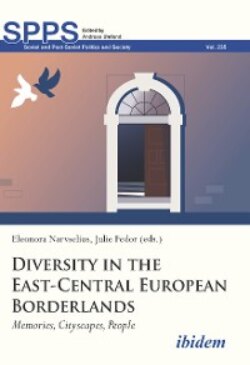Читать книгу Diversity in the East-Central European Borderlands - Группа авторов - Страница 17
На сайте Литреса книга снята с продажи.
Chişinău/Kishinev in the Postwar Soviet Period
ОглавлениеSoviet power legitimized itself by memorial policies that were also linked to ethnic questions. The Soviet narrative merged all war victims together as “Soviet citizens,” thus eliding the Holocaust. Romanians and Moldovans were described as different nationalities and Romanian troops as “foreign occupiers.”
Although it would have been possible to restore the main features of the old urban fabric in Old Chişinău, the Soviet authorities proceeded to demolish many old buildings, including the St. Ilie church, the Michael and Gabriel Cathedral, the Lutheran church, and several synagogues. The Metropolitan Palace was replaced by the local Soviet building, now the parliament, furnishing it with a large square for 1st of May-parades. The streets were once more renamed, with the central boulevard now becoming Lenin Avenue.
Urban planning was used to glorify the new rule through monumental, neo-classicist buildings and memorials (Caşu 2011: 111). According to the new city development plan for Chişinău produced by the architects Aleksei Viktorovich Shchusev (1873–1949)32 and Robert Kurtz (1911–80), the Russian grid city was to be extended into the very heart of the pre-1812 Moldovan town, with a new boulevard to the airport as the pinnacle.33 Parts of the plan were implemented, replacing and erasing all traces of the former Piaţa Veche with adjacent churches and synagogues. Only the Armenian church was spared, surviving in a rear courtyard of a set of apartment buildings. Elsewhere, buildings were restored, sometimes in a process involving abusive expropriation, plunder, and corruption, disregarding ownership rights (Caşu 2011: 111–12; Nesterov 2011b: 136).
The Odeon cinema was inaugurated in 1946 (and later completely reconstructed and re-opened in 1962), and the National Theater in 1954. The Officers’ Club was finished in the 1950s on a smaller scale, as the Hotel “Moldova,” today used by the bank Mobiasbanca. Although building projects began in the interwar years, they were claimed as “Soviet” projects (Nesterov 2011a: 96–97).34 Several buildings representing the Russian rule (1812–1917), selected for ideological reasons, were restored. The Noblemen’s Club was replaced by the cinema Patria, partly using the old foundations, and the Schwarzman and Barbalat buildings by new apartments (ibid.: 138). The City Hall, Hotel Suisse, the Metropolitan Hotel, and some government buildings were reconstructed. The large Choral Synagogue was radically rebuilt to house the Russian Chekhov Theater, and the main Cathedral was used for industrial exhibitions. The central part of present-day Bulevardul Ştefan cel Mare was already from 1947 edged by monumental three-story buildings in Soviet neo-baroque style with shops, offices, and apartments. The new railway station, Hotel “Chişinău,” and Patria cinema were designed in a pronounced Moldovan style, reminiscent of neo-Romanesc or Brâncoveanu style (ibid.: 128–41). This so-called “Socialist Realist” architecture that utilized national forms was followed by rationalistic modernism from around 1960 (ibid.: 136–41).
The Soviet attitude towards the old, lower part of Chişinău is illustrated by a text by Shchusev from 1945: “The lower part of the city, the old Moldovan Chişinău […], with crooked streets and old churches and poor urban planning, was abandoned […]. Here, huddled the poor […]. With the help of radial boulevards and squares, it is becoming a very well-organized part of the modern city” (Shchusev 1945).35 In the same year, Robert Kurtz wrote about the small streets and malls of the city: “These narrow limits do not fit into the life of Soviet people, united in large groups looking at an early age to public initiative and collective recreation and sports” (Kurtz 1945).36
The General Plan of 1969 aimed to replace the area around Strada Vineri with a new thoroughfare, in practice erasing the remaining urban fabric of the Old Town (Kurtz, Shoikhet, and Miselsky 1965: 84).37 Parts of the Old Town were replaced by high-rise apartment buildings of the suburban type in the 1970s and 1980s. Some houses were destroyed in the 1977 earthquake.
